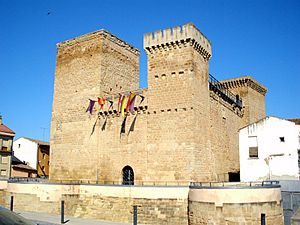Castle of Aguas Mansas facts for kids
Quick facts for kids Castle of Aguas Mansas |
|
|---|---|
| Native name Spanish: Castillo de Aguas Mansas |
|
 |
|
| Location | Agoncillo, La Rioja, Spain |
| Built | 13th and 14th centuries |
| Restored | 1990 |
| Official name: Castillo de Aguas Mansas | |
| Type | Non-movable |
| Criteria | Monument |
| Designated | 1983 |
| Reference no. | RI-51-0004824 |
| Lua error in Module:Location_map at line 420: attempt to index field 'wikibase' (a nil value). | |
The Castle of Aguas Mansas is a cool medieval castle in Agoncillo, La Rioja, Spain. Its name means "Castle of Calm Waters" or "Quiet Waters." This amazing castle was built a long time ago, between the 13th and 14th centuries, and it's still in great shape today!
On the castle's eastern side, you can see the coat of arms of the Medrano family. It also has the Calatrava Cross. This shows that the Medrano family owned the castle for a long time.
Today, the castle is used by the Town hall of Agoncillo. It also houses the town's Library and other local offices. You can visit the castle on weekdays during office hours, but you usually need to book your visit ahead of time.
Contents
Discover the Castle's History
The Castle of Aguas Mansas has a long and interesting past. It has been mentioned in old documents for centuries.
Early Days of the Castle
An old book called the Codex Vigilanus talks about a Muslim castle in this area. It says that King Sancho Garcés of Pamplona captured it in the early 900s. Later, in the 11th and 12th centuries, other documents mention a strong fortress called Aguas Mansas or Aguas Muertas. People knew it had excellent defenses.
Because it was so strong, many wanted to own it. In 1191, King Alfonso VIII of Castile made a deal about the lands around the castle.
Who Owned the Castle?
In 1337, a man named Rodrigo Alfonso de Medrano bought the village and the castle. He was a crossbowman for King Alfonso XI. Rodrigo started making big changes to the castle. He wanted to update it to the style of the 14th century.
In his will from 1345, he wrote that he spent a lot of money "building the castle and the village." This shows how much he cared about this place.
Battles and New Owners
During battles between Peter the Cruel and Henry of Trastámara, the castle briefly belonged to Charles II of Navarre. But not for long!
By 1392, the castle was owned by Rodrigo Alfonso de Agoncillo. He left it to his nephew, Diego López de Medrano. The castle then stayed with Diego's family, the Counts of Siruela, until the 1800s.
Explore the Castle's Architecture
The Castle of Aguas Mansas has a unique design. It was built in two main stages.
Castle Design and Towers
The castle is shaped almost like a rectangle. It has four strong, prism-shaped towers at each corner. These towers still have their machicolations today. Machicolations are openings at the top of a castle wall. Defenders could drop things through them onto attackers below.
The castle was built with large, cut stones. The first part was built in the mid-14th century, on top of an even older building. The second part was added in the late 15th century.
The tallest tower has four floors. It has a door with a pointed arch, which is a common style in medieval architecture. The smallest tower is called de las palomas (of the doves). It has well-preserved modillions, which are decorative brackets that supported the machicolations.
The Parade Ground
The castle's main courtyard, called the parade ground, was updated in the 16th century. It looks like a cloister, which is a covered walkway often found in monasteries. It has two levels. The upper gallery rests on semicircular arches, which are rounded arches.
In 1990, the castle had a big restoration. Workers removed some rooms that were added in the 18th and 19th centuries. This helped the castle look more like it did in its original medieval form.
See also
 In Spanish: Castillo de Aguas Mansas para niños
In Spanish: Castillo de Aguas Mansas para niños

